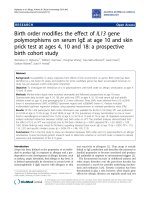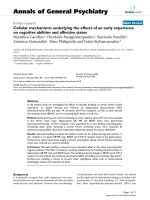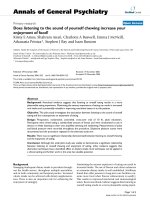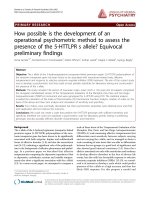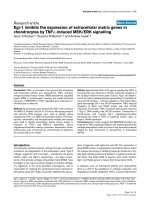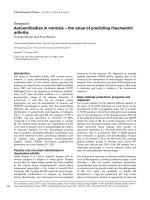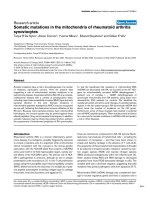Báo cáo y học: "New treatments addressing the pathophysiology of hereditary angioedema" docx
Bạn đang xem bản rút gọn của tài liệu. Xem và tải ngay bản đầy đủ của tài liệu tại đây (279.97 KB, 7 trang )
BioMed Central
Page 1 of 7
(page number not for citation purposes)
Clinical and Molecular Allergy
Open Access
Review
New treatments addressing the pathophysiology of hereditary
angioedema
Alvin E Davis III
Address: Professor of Pediatrics, Harvard Medical School, Senior Investigator, Immune Disease Institute, 800 Huntington Avenue, Boston, MA
02114, USA
Email: Alvin E Davis -
Abstract
Hereditary angioedema is a serious medical condition caused by a deficiency of C1-inhibitor. The
condition is the result of a defect in the gene controlling the synthesis of C1-inhibitor, which
regulates the activity of a number of plasma cascade systems. Although the prevalence of hereditary
angioedema is low – between 1:10,000 to 1:50,000 – the condition can result in considerable pain,
debilitation, reduced quality of life, and even death in those afflicted. Hereditary angioedema
presents clinically as cutaneous swelling of the extremities, face, genitals, and trunk, or painful
swelling of the gastrointestinal mucosa. Angioedema of the upper airways is extremely serious and
has resulted in death by asphyxiation.
Subnormal levels of C1-inhibitor are associated with the inappropriate activation of a number of
pathways – including, in particular, the complement and contact systems, and to some extent, the
fibrinolysis and coagulation systems.
Current findings indicate bradykinin, a product of contact system activation, as the primary
mediator of angioedema in patients with C1-inhibitor deficiency. However, other systems may play
a role in bradykinin's rapid and excessive generation by depleting available levels of C1-inhibitor.
There are currently no effective therapies in the United States to treat acute attacks of hereditary
angioedema, and currently available agents used to treat hereditary angioedema prophylactically
are suboptimal. Five new agents are, however, in Phase III development. Three of these agents
replace C1-inhibitor, directly addressing the underlying cause of hereditary angioedema and re-
establishing regulatory control of all pathways and proteases involved in its pathogenesis. These
agents include a nano-filtered C1-inhibitor replacement therapy, a pasteurized C1-inhibitor, and a
recombinant C1-inhibitor isolated from the milk of transgenic rabbits. All C1-inhibitors are being
investigated for acute angioedema attacks; the nano-filtered C1-inhibitor is also being investigated
for prophylaxis of attacks. The other two agents, a kallikrein inhibitor and a bradykinin receptor-2
antagonist, target contact system components that are mediators of vascular permeability. These
mediators are formed by contact system activation as a result of C1-inhibitor consumption.
Review
Hereditary angioedema (HAE) is an autosomal dominant
condition caused by mutations to the gene controlling
C1-inhibitor production. This gene would seem to be rel-
Published: 14 April 2008
Clinical and Molecular Allergy 2008, 6:2 doi:10.1186/1476-7961-6-2
Received: 28 December 2007
Accepted: 14 April 2008
This article is available from: />© 2008 Davis; licensee BioMed Central Ltd.
This is an Open Access article distributed under the terms of the Creative Commons Attribution License ( />),
which permits unrestricted use, distribution, and reproduction in any medium, provided the original work is properly cited.
Clinical and Molecular Allergy 2008, 6:2 />Page 2 of 7
(page number not for citation purposes)
atively mutable. As many as 25% of new patients have no
family history and presumably represent new mutations.
In addition, over 150 different mutations have been iden-
tified [1-3]. Most of the identified mutations have been
included in a C1-inhibitor gene mutation database [4].
Although the exact prevalence of HAE is unknown, it has
been estimated that the condition affects between 1 in
10,000 to 1 in 100,000 individuals [5-7]. HAE was first
clinically described by Heinrich Quincke, in 1882. Vir-
ginia Donaldson and colleagues, about 75 years later,
identified the biochemical defect leading to HAE as sub-
normal or ineffective levels of C1-inhibitor. C1-inhibitor
regulates the activity of the first component of the comple-
ment system, C1-esterase, controlling both C1's rate of
activation, as well as deactivating activated C1. C1-inhib-
itor is also able to inactivate a number of other proteases
in other plasma cascade systems [1,3,8].
Specific mutations have resulted in two main types of
HAE. Type 1 (accounting for approximately 85% of HAE
patients) is characterized by subnormal levels of circulat-
ing
C1-inhibitor. Given the heterozygous nature of the condi-
tion, it might be presumed that plasma levels of C1-inhib-
itor in individuals with the mutation would be 50% of
normal. In fact, levels are typically much lower – between
5% and 30% [2,3]. These low levels suggest enhanced
depletion of C1-inhibitor – the rate of consumption
exceeding the rate of ongoing synthesis – in patients with
the genetic defect, even during asymptomatic periods [9].
In Type 2 HAE (approximately 15% of patients), C1-
inhibitor plasma levels are normal or elevated. High con-
centrations of the mutant protein are typically present due
to the increased half-life of the dysfunctional C1-inhibi-
tor, which fails to form inhibitor-protease complexes. Dif-
ferences in disease severity, manifestation, or clinical
course have not been associated with HAE type, but both
types are associated with a deficiency in functional C1-
inhibitor [2,3].
Clinical Presentation
Increased levels of vascular permeability factors associated
with C1-inhibitor deficiency may result in sudden local
diminishments of endothelial barrier function. Plasma
may then leak from capillaries deeper into cutaneous or
mucosal tissue layers [1,8]. HAE-associated swelling typi-
cally occurs in the facial area and extremities, the upper
airways, the genitourinary tract, and in the gastrointestinal
mucosa. Far less frequent though also reported are epi-
sodes involving the soft palate, the tongue, urinary blad-
der, chest, muscles, joints, kidneys, and the esophagus
[10]. Cutaneous edema is debilitating, may be painful,
and can severely affect quality of life. Abdominal
angioedema can be extremely painful, severe enough to
cause gastrointestinal tract obstruction, and is often
accompanied by diarrhea and/or vomiting [1,2,8,11]. In a
retrospective assessment of 33,671 abdominal
angioedema attacks in 153 patients, Bork and colleagues
reported a mean maximal pain score of 8.4 (range 1–10).
Vomiting accompanied 71% of the attacks, and diarrhea
41%. Circulatory collapse and loss of consciousness were
also described [12]. Abdominal angioedema is often mis-
taken for a surgical emergency; as many as 1/3 of patients
with undiagnosed HAE have undergone exploratory
laparotomy or appendectomy during abdominal attacks
[13].
The most serious form of HAE affects the upper airways
and involves swelling of the larynx and pharynx. Prior to
the development of effective diagnostic techniques and
acute care interventions (where they are available) as
many as 40% of patients with HAE died from an episode
of laryngeal edema. Bork and associates have also
reported a mortality rate as high as 50% associated with
laryngeal edema in patients with undiagnosed HAE
[14,15]. Frequency of attacks and age of onset may show
considerable variation, and the pattern of attacks may
change with age. Attacks typically involve a single site,
though simultaneous attacks at multiple sites are not
uncommon [1].
C1-inhibitor
C1-inhibitor is a protein whose biological function is to
inhibit a number of other proteases involved in the
response to infection, injury, or inflammation. C1-inhib-
itor is the primary regulator of contact and complement
system activation, and may play a minor role in the regu-
lation of coagulation and fibrinolysis [2,3,16,17]. Inap-
propriate activation of these plasma pathways,
particularly of the complement and contact systems, as a
result of C1-inhibitor deficiency, is a central component
in the pathophysiology of HAE [1,2,8,18,19]. C1-inhibi-
tor inactivates C1r and C1s, the serine protease subcom-
ponents of the first component of the complement
pathway [20]. C1-inhibitor also may play a minor role in
the regulation of the coagulation cascade by means of its
inhibitory effects on factor XIIa and factor XIa, as well as
on thrombin formation [1,2,18,20,21]. In the fibrinolytic
pathway, C1-inhibitor participates in the inactivation of
plasmin and tissue plasminogen activator (tPA). How-
ever, under normal physiologic conditions, C1-inhibitor
is not an important inhibitor of either of these proteases
[1,2,19,20,22]. In the contact system pathway, C1-inhibi-
tor inactivates both factor XIIa and active kallikrein,
thereby preventing both the activation of kallikrein from
prekallikrein and the formation of bradykinin, a vascular
permeability factor [2,20,21,23-25]. Given its regulatory
effects on kallikrein, C1-inhibtor might well have been
designated "kallikrein inhibitor."
Clinical and Molecular Allergy 2008, 6:2 />Page 3 of 7
(page number not for citation purposes)
Mediators of Vascular Permeability
Although C1-inhibitor deficiency has been known to be
the underlying cause of HAE for more than 40 years, the
actual mediator(s) of the vascular permeability character-
istic of the disease remains the subject of continued inves-
tigation. Because the subcutaneous edema associated with
HAE is often painless, and because subcutaneous injec-
tions of bradykinin are acutely painful, investigators ini-
tially believed that a complement-derived permeability
factor would be the most likely mediator of the
angioedema associated with C1-inhibitor deficiency
[2,20]. A complement-derived substance, designated C2
kinin, was initially proposed as a candidate permeability
mediator, but subsequent investigations failed to verify its
activity [26-28].
Bradykinin, a nonapeptide released from kininogen by
kallikrein cleavage, is a downstream product of contact
system activation. It is capable of inducing edema as a
result of its effects on vasodilation and microvessel per-
meability [29]. In vivo investigations demonstrated rapid
elevations in bradykinin in C1-inhibitor-deficient
patients during HAE attacks [30,31]. However, the strong
linkage of bradykinin and angioedema attacks does not
preclude involvement of other plasma cascade products,
such as plasmin and thrombin, in the initiation and dura-
tion of HAE attacks. Clinical and experimental data have
indicated that thrombin formation in the coagulation
pathway is increased during HAE attacks [18]. Several
lines of evidence suggest that plasmin and the fibrinolytic
pathway may also have some involvement in HAE [2,19].
Pathogenesis of HAE Attacks
The main pathogenic mechanism for the generation of
HAE attacks is depletion and/or consumption of C1-
inhibitor. Clinically, attacks of HAE appear to have a
number of environmental and pathophysiological trig-
gers: eg, prolonged mechanical pressure, trauma, emo-
tional stress, menses, or intercurrent illness, particularly
inflammation [1,8]. Angiotensin converting enzyme
inhibitor therapy may trigger attacks in individuals with
HAE [32]. In persons with a mutation associated with C1-
inhibitor deficiency, angioedema attacks may occur spon-
taneously even in the absence of an overt precipitating fac-
tor. Chronically low levels of C1-inhibitor – ≤ 30% of
normal – suggest the possibility of complement and con-
tact systems activation even during apparently symptom-
free periods, so-called autoactivation of the plasma cas-
cade systems. Any further reductions in available C1-
inhibitor would be associated with development of
angioedema symptoms [2].
Since C1-inhibitor is a primary regulator of a number of
proteases and pathways, the activation of any of these pro-
teases and pathways could also lead to further consump-
tion of C1-inhibitor and the development of HAE
symptoms. Chronic, low-level activation of the comple-
ment pathway could lead to the inappropriate activation
of the contact pathway. Vascular permeability and edema
would result from the rapid and excessive release of brady-
kinin [1,20]. Cugno and colleagues have speculated that
the significant increases in prothrombin fragment F1+2 in
the coagulation pathway may involve increased plasma
levels of factor XII, an initiator of the contact pathway that
is activated during HAE attacks [18]. In addition, factor
XIIa and plasmin may serve to activate C1 in the comple-
ment pathway, while factor XIIa or kallikrein in the con-
tact pathway may generate plasmin from plasminogen in
the fibrinolytic pathway [20].
While it may be that only the contact system and bradyki-
nin are directly implicated in the release of vascular per-
meability mediators and angioedema, activation of other
plasma systems, particularly the complement system, may
contribute to the genesis, severity, and duration of the
attack by contributing to the consumption of C1-inhibi-
tor. Activation of these other pathways may also contrib-
ute proteases and factors that could play a role in HAE
attacks. These processes result in a sequence of C1-inhibi-
tor consumption, complement activation, and release of
bradykinin during every acute attack until appropriate
therapy is administered to raise serum levels of C1-inhib-
itor, or until remission spontaneously occurs [1,8].
Therapies for the Management of HAE
Since no effective therapies for acute HAE attacks are avail-
able in the United States, treatment is suboptimal, and
may often result in significant medical, emotional, and
economic consequences. Frequent hospitalizations and
surgical procedures have been associated with this condi-
tion, particularly in untreated or inadequately treated
patients. In the case of life-threatening laryngeal
angioedema, intubation and tracheotomy have been indi-
cated. Inaccurate diagnosis of HAE has resulted in unnec-
essary surgeries and other medical procedures [1,8,10,32].
As with acute therapy, currently available HAE prophylac-
tic treatment options in the U.S. are suboptimal. Attenu-
ated androgens, particularly danazol and stanozolol, have
been used for decades, with good efficacy – while these
agents do not prevent all attacks, they do reduce the
number. Long-term use of these agents, however, is asso-
ciated with substantial risk of side effects and adverse
events, including weight gain, viralization and menstrual
irregularities in women, and dyslipidemia [1,8,33-36].
Szeplaki and colleagues, who found long-term danazol
therapy to be associated with the development of unfavo-
rable lipid profiles, concluded that long-term danazol
prophylaxis should be considered a significant risk factor
for atherosclerosis in patients with HAE, a risk that would
Clinical and Molecular Allergy 2008, 6:2 />Page 4 of 7
(page number not for citation purposes)
be compounded in patients also experiencing blood pres-
sure elevations as a result of danazol therapy [36].
In a long-term assessment of HAE prophylaxis with atten-
uated androgens (median treatment time:125.5 months),
Cicardi and colleagues noted an apparent association
between androgen therapy and incidence of arterial
hypertension. While only a single untreated patient (3%)
developed hypertension during the study period, nine
danazol-treated patients (25%; age range, 35 to 74 years,
median age 60) developed hypertension – in some cases
within a few months of therapy initiation [33]. Hyperten-
sion was also found to be a significant adverse event in a
long-term study of danazol prophylaxis in women with
HAE (mean age 35.2 years, mean duration of therapy 60
months). In this study 10% of patients (6/60) developed
hypertension [37]. Salt and water retention associated
with danazol therapy may explain both the weight gain
and hypertension observed in some patients.
Long-term administration of attenuated androgens has
been associated with a number of liver disorders, includ-
ing hepatic cell necrosis and cholestasis [1,38,39]. There
have been case reports of a number of instances of hepa-
totoxicity associated with long-term danazol therapy,
including hepatocellular adenoma and hepatocellular car-
cinoma. Bork and colleagues have described four cases of
hepatocellular adenoma associated with long-term (> 10
yrs) danazol prophylaxis for HAE [40,41]. Several cases of
hepatocellular carcinoma associated with long-term dan-
azol therapy have also been reported, although in these
instances the patients were not being treated for HAE (ie,
a female patient with systemic lupus erythematosus
treated for 4 years with danazol; and a female patient with
idiopathic thrombocytopenia purpura refractory to corti-
cotherapy, intravenous immunoglobulins, vincristine,
and splenectomy, treated with 600 mg danazol daily for 5
years) [42,43].
It is also of concern that the prevalence and severity of
adverse effects associated with attenuated androgens
appear to increase with dosage strength and duration of
therapy [36,44,45].
The lack of therapeutic options should soon be remedied.
Five new therapies are in Phase III clinical development: a
kallikrein inhibitor (DX-88), a bradykinin receptor-2
antagonist (Icatibant), and three C1-inhibitor replace-
ment therapies.
Designed by phage display technology, DX-88 is a recom-
binant protein capable of binding to and inhibiting
human kallikrein. It has a plasma half-life of approxi-
mately 70 minutes when administered intravenously (IV)
and 2 hours when administered subcutaneously (SC). It
has been evaluated for safety and efficacy in several trials
at a range of doses (eg, 5, 10, 20, or 40 mg/m
2
, given intra-
venously). Patients have reported significant symptom
improvement versus placebo. Serious adverse events have
been reported in a small number of patients, including
shortness of breath and throat edema, as well as pro-
longed prothrombin and thrombin in one patient. Four
patients were observed with post-treatment activated par-
tial thromboplastin times considered abnormal by the
investigator [1,46-48].
Icatibant, a bradykinin receptor-2 antagonist is a synthetic
decapeptide with a structure similar to bradykinin; it is a
highly specific antagonist for bradykinin receptor-2, with
a plasma half-life of approximately 2–4 hours [49]. In an
uncontrolled pilot study, 15 patients (with 20 HAE
attacks) were treated with one of five dosage strengths of
Icatibant (three IV doses: 0.4 mg/kg body weight admin-
istered IV over a period of 2 h; 0.4 mg/kg administered
over a period of 0.5 h; 0.8 mg/kg administered over a
period of 0.5 h; or two SC doses: 30 mg SC; 45 mg SC).
Compared with untreated attacks, Icatibant reduced the
mean time to onset of symptom relief by 97%, from 42 ±
14 hours to 1.16 ± 0.95 hours for all dosage groups. How-
ever, relapse might be an issue. Four patients experienced
five attacks subsequent to treatment (between 14 hours
and 27 hours). The 5 attacks were successfully treated with
rescue C1-inhibitor (Berinert P (1000 U or 500 U). All
patients in whom attacks recurred showed initial response
to Icatibant, including symptom relief [49].
Three C1-inhibitor replacement products are also in Phase
III development: a pasteurized C1-inhibitor, Berinert P,
with a plasma half-life of between 32 and 47 hours [50];
a recombinant human C1-inhibitor isolated from the
milk of transgenic rabbits, rhC1INH (Rhucin), with a
plasma half-life of ~3 hours [1,51]; and a nano-filtered
C1-inhibitor, Cinryze (pharmacodynamics/pharmacoki-
netic data not yet available; Cetor, a comparable agent
though lacking the nano-filtration process in its prepara-
tion, has a half-life of 48 ± 10 hours)[52]. Nano-filtration
is a purification process that has a number of efficient and
robust steps for both virus inactivation or removal and
prion removal [53]. C1-inhibitor replacement therapy not
only suppresses bradykinin release by inactivation of fac-
tor XIIa and kallikrein, but also suppresses activation of
the complement system and perhaps of the fibrinolytic
and coagulation pathways. Although unproven, it is pos-
sible that ongoing activation of these pathways indirectly
contributes to the contact system activation via two mech-
anisms. First, activation of proteases susceptible to inacti-
vation by C1-inhibitor would result in depletion of C1-
inhibitor. Complement system activation, in particular,
would deplete C1-inhibitor because C1r and C1s are
present in greater quantities than most of the other pro-
Clinical and Molecular Allergy 2008, 6:2 />Page 5 of 7
(page number not for citation purposes)
teases and because complement activation in HAE tends
to be extensive. Secondly, a number of in vitro experi-
ments have suggested, as described previously, that there
may be interactions among the contact, complement and
fibrinolytic systems in which a protease in one system
directly activates a protease in one or both of the other sys-
tems. If such interactions take place in vivo, activation of
one system could eventuate in activation of all three sys-
tems. This would result in release of bradykinin via con-
tact system activation and would further enhance C1-
inhibitor consumption. However, it must be emphasized
that these interactions have not been shown to occur in
vivo.
By inhibiting all of the susceptible proteases of the com-
plement, contact, and fibrinolytic pathways, purified C1-
inhibitor replacement therapy may turn out to provide
more efficient control of angioedema symptoms. How-
ever, this assumption remains to be proven. A related
issue is the observation that some patients, following
treatment, develop recurrent attacks of angioedema after
24 – 48 hours. It is possible that these recurrent attacks are
a function of the half-life of the therapeutic agent or they
could be related to the absence of inhibition of all the pro-
teases susceptible to C1-inhibitor. Long-term recovery
from an attack presumably requires the stabilization of
levels of C1-inhibitor that are sufficiently high to prevent
a recurrence of significant contact system activation with
resultant bradykinin release. If activation of both the con-
tact and complement systems is suppressed, C1-inhibitor
levels might recover more rapidly and early recurrences
might be suppressed. Because plasma-derived C1-inhibi-
tor has a longer half-life and is a broader spectrum inhib-
itor, it has been assumed that such recurrences occur less
frequently with C1-inhibitor therapy but that assumption
awaits verification.
C1-inhibitor has been available for decades in Europe
where it has compiled considerable clinical efficacy and
safety data. In the United States, Waytes and colleagues
treated 11 patients experiencing a total of 55 HAE attacks
with vapor-heated C1-inhibitor concentrate and 11
patients experiencing 49 HAE attacks with placebo [54].
Nearly all HAE attacks (95%) treated with C1-inhibitor
responded to treatment, with an average symptom
improvement response time of ~55 minutes, compared
with just 12% of placebo-treated attacks (P < 0.001). No
adverse events were associated with C1-inhibitor concen-
trate treatment. As mentioned, three C1-inhibitor prod-
ucts are undergoing or have completed Phase III
development in the U.S.
Where it has been available, C1-inhibitor concentrate
purified from human plasma has also been used effec-
tively as a long-term prophylaxis for HAE attacks [1].
Waytes and colleagues reported > 60% reduction in dis-
ease activity in patients treated prophylactically with C1-
inhibitor. Treatment consisted of 5 infusions of either C1-
inhibitor or placebo every third day over two 17-day peri-
ods separated by at least 3 weeks. The second study period
alternated the treatments. No patient receiving C1-inhibi-
tor concentrate demonstrated objective signs of either
laryngeal or genitourinary edema, whereas 4 of 6 placebo-
treated patients demonstrated evidence of attacks in one
or both of those systems [54].
Additionally, in a small study of patients self-administer-
ing C1-inhibitor concentrate, 12 patients in the prophy-
lactic group (10 patients with hereditary C1-inhibitor
deficiency and 2 patients with acquired C1-inhibitor defi-
ciency; there were also 31 patients in the on-demand
group) experienced an attack rate reduction from a mean
of 4 attacks per month to 0.3 attacks per month. The mean
interval between prophylactic injections was 6.8 ± 1.0
days. The mean follow-up time for these patients was 3.5
years [55]. In the United States, one of the C1-inhibitors
currently in development, the nano-filtered agent, cin-
ryze, is also seeking an indication for prophylaxis in addi-
tion to an indication for acute attack treatment.
Whether or not a patient with HAE requires a prophylaxis
regimen will upon a number of patient selection criteria,
including frequency and severity of attacks, and the site of
attacks. Data concerning the number or percentage of
HAE patients either receiving prophylaxis therapy, or who
might be candidates for prophylaxis, are sparse. In their
review of clinical experience of 235 HAE patients over a
period of 19 years, Agostoni and Cicardi found that 30%
experienced more than 1 attack per month; these patients
were considered candidates for continuous prophylactic
treatment [13]. A Spanish registry study of 444 patients
with HAE found that treating physicians considered
approximately 85% of those patients to be symptomatic.
Of those patients, 63% received long-term prophylaxis,
although the criteria upon which prophylaxis was recom-
mended (by physicians) and accepted (by patients) were
not specified [6]. As stated, the decision to recommend,
and to accept, HAE prophylaxis should be based upon a
number of criteria including symptom severity, side
effects' concerns, risk and impairment, etc. Therapy
should always be individually tailored to meet specific
patient needs and requirements.
Conclusion
Hereditary angioedema is a genetic disorder whose under-
lying cause is a deficiency of C1-inhibitor. Although prev-
alence is relatively low, the disease can result in significant
morbidity and mortality for those afflicted. The goals of
HAE therapy are disease management – ie, preventing
attacks, ideally by re-establishing normal physiology, and
Clinical and Molecular Allergy 2008, 6:2 />Page 6 of 7
(page number not for citation purposes)
improving quality of life; and crisis management – ie,
treating acute attacks with utmost efficacy, rapidity, and
safety. Several new therapies for HAE are in development.
The kallikrein inhibitor and the bradykinin receptor-2
antagonist target biologically active products of contact
pathway dysregulation caused by C1-inhibitor deficiency.
These agents inhibit the release or block the activity of
bradykinin, the primary mediator of vascular permeabil-
ity associated with HAE. They do not address the primary
pathophysiologic cause of HAE – C1-inhibitor deficiency.
Several C1-inhibitor replacement products are in develop-
ment, including a pasteurized product, a transgenic agent,
and a nano-filtered C1-inhibitor concentrate. C1-inhibi-
tor replacement therapy addresses the primary cause of
HAE by replacing C1-inhibitor. C1-inhibitor products
have been available for decades in Europe, where they
have been the treatment of choice for acute attacks. C1-
inhibitor concentrate restores regulatory control over all
pathways and biologically active products that may play a
role, either directly or indirectly, in the pathogenesis of
HAE.
Abbreviations
Hereditary angioedema, HAE; intravenous, IV; subcutane-
ous, SC.
Competing interests
Financial Competing Interests: In the past five years, the
author has received reimbursements and consulting fees
from each of the following companies: CSL Behring,
Dyax, Jerini, Lev Pharmaceuticals, and Pharming Group
NV. Lev Pharmaceuticals provided funds for the article-
processing charge for this manuscript.
Acknowledgements
I thank Robert McCarthy, Ph.D., who provided medical writing services on
behalf of Lev Pharmaceuticals.
References
1. Agostoni A, Aygoren-Pursun E, Binkley KE, Blanch A, Bork K, Bouillet
L, Bucher C, Castaldo AJ, Cicardi M, Davis AE III, et al.: Hereditary
and acquired angioedema: problems and progress: proceed-
ings of the third C1 esterase inhibitor deficiency workshop
and beyond. J Allergy Clin Immunol 2004, 114:S51-131.
2. Davis AE III: Mechanism of angioedema in first complement
component inhibitor deficiency. Immunol Allergy Clin North Amer-
ica 2006, 26:633-651.
3. Fay A, Abinun M: Current management of hereditary angio-
oedema (C'1 esterase inhibitor deficiency). J Clin Pathol 2002,
55:266-270.
4. C1 inhibitor gene mutation database [ />]
5. Bork K, Barnstedt S-E: Treatment of 193 episodes of laryngeal
edema with C1-inhibitor concentrate in patients with hered-
itary angioedema. Arch Intern Med 2001, 161:714-718.
6. Roche O, Blanch A, Caballero T, Sastre N, Callejo D, Lopez TM:
Hereditary angioedema due to C1-inhibitor deficiency:
patient registry and approach to the prevalence in Spain. Ann
Allergy Asthma Immunol 2005, 94:498-503.
7. Stray-Pedersen A, Abrahamsen TG, Froland SS: Primary immuno-
deficiency diseases. J Clin Immunol 2000, 20:477-485.
8. Frank MM: Hereditary angioedema: the clinical syndrome and
its management in the United States. Immunol Allergy Clin North
America 2006, 26(4):653-668.
9. Quastel M, Harrison R, Cicardi M, Alper C, Rosen F: Behavior in
vivo of normal and dysfunctional C1 inhibitor in normal sub-
jects and patients with hereditary angioneurotic edema. J
Clin Invest 1983, 71:1041-1046.
10. Bork K, Meng G, Staubach P, Hardt J: Hereditary angioedema:
new findings concerning symptoms, affected organs, and
course. Am J Med 2006, 119:267-274.
11. Huang S-W: Results of an on-line survey of patients with
hereditary angioedema. Allergy Asthma Proc 2004, 25:127-131.
12. Bork K, Staubach P, Eckardt AJ, Hardt J: Symptoms, courses, and
complications of abdominal attacks in hereditary
angioedema due to C1-inhibitor deficiency. Am J Gastroenterol
2006, 101:619-627.
13. Agostoni A, Cicardi M: Hereditary and acquired C1-inhibitor
deficiency: Biological and clinical characteristics in 235
patients. Medicine 1992, 71:206-215.
14. Bork K, Hardt J, Schicketanz KH, Ressel N: Clinical studies of sud-
den upper airway obstruction in patients with hereditary
angioedema due to C1 esterase inhibitor deficiency. Arch
Intern Med 2003, 163:1229-1235.
15. Bork K, Siedlecki K, Bosch S, Schopf RE, Kreuz W: Asphyxiation by
laryngeal edema in patients with hereditary angioedema.
Mayo Clin Proc 2000, 75:349-354.
16. Bos IGA, Hack CE, Abrahams JP: Structural and functional
aspects of C1-inhibitor. Immunobiol 2002, 205:518-533.
17. Patston PA, Gettins P, Beechem J, Schapira M: Mechanism of serpin
action: evidence that C1 inhibitor functions as a suicide sub-
strate. Biochemistry 1991, 30:8876-8882.
18. Cugno M, Cicardi M, Bottasso B, Coppola R, Paonessa R, Mannucci
PM, Agostoni A: Activation of the coagulation cascade in C1-
inhibitor deficiencies. Blood 1997, 89:3213-3218.
19. Cugno M, Hack CE, Boer JPd, Eerenberg AJ, Agostoni A, Cicardi M:
Generation of plasmin during acute attacks of hereditary
angioedema. J Lab Clin Med 1993, 121:38-43.
20. Davis AE III: The pathophysiology of hereditary angioedema.
Clin Immunol 2005, 114:3-9.
21. Pixley RA, Schapira M, Colman RW: The regulation of human fac-
tor XIIa by plasma proteinase inhibitors. J Biol Chem 1985,
260:1723-1729.
22. Booth NA, Walker E, Maughan R, Bennett B: Plasminogen activa-
tor in normal subjects after exercise and venous occlusion: t-
PA circulates as complexes with C1-inhibitor and PAI-1.
Blood 1987, 69:1600-1604.
23. de Agostini A, Lijnen HR, Pixley RA, Colman RW, Schapira M: Inac-
tivation of factor-XII active fragment in normal plasma: pre-
dominant role of C1-inhibitor. J Clin Invest 1984, 93:1542-1549.
24. Schapira M, Scott CF, Colman RW: Contribution of plasma pro-
tease inhibitors to the inactivation of kallikrein in plasma. J
Clin Invest 1982, 69:462-468.
25. van der Graaf F, Koedam JA, Bouma BN: Inactivation of kallikrein
in human plasma. J Clin Invest 1983, 71:149-158.
26. Donaldson VH, Ratnoff OD, Silva WDd, Rosen FS: Permeability-
increasing activity in hereditary angioneurotic edema
plasma. J Clin Invest
1969, 48:642-653.
27. Fields T, Ghebrewihet B, Kaplan A: Kinin formation in hereditary
angioedema plasma: evidence against kinin derivation from
C2 and in support of spontaneous formation of bradykinin.
Journal of Allergy and Clinical Immunology 1983, 72(1):54-60.
28. Shoemaker LR, Schurman SJ, Donaldson VH, Davis AE III: Heredi-
tary angioneurotic edema: Characterization of plasma kinin
and vascular permeability-enhancing activities. Clin Exp Immu-
nol 1994, 95:22-28.
29. Colman RW, Schmaier AH: Contact system: A vascular biology
modulator with anticoagulant, profibrinolytic, antiadhesive,
and proinflammatory attributes. Blood 1997, 90:3819-3843.
30. Nussberger J, Cugno M, Amstutz C, Cicardi M, Pellacani A, Agostoni
A: Plasma bradykinin in angio-oedema. Lancet 1998,
351:1693-1697.
31. Nussberger J, Cugno M, Cicardi M, Agostoni A: Local bradykinin
generation in hereditary angioedema. J Allergy Clin Immunol
1999, 104:1321-1322.
32. Nzeako UC, Frigas E, Tremaine WJ: Hereditary angioedema. Arch
Intern Med 2001, 161:2417-2429.
Publish with BioMed Central and every
scientist can read your work free of charge
"BioMed Central will be the most significant development for
disseminating the results of biomedical research in our lifetime."
Sir Paul Nurse, Cancer Research UK
Your research papers will be:
available free of charge to the entire biomedical community
peer reviewed and published immediately upon acceptance
cited in PubMed and archived on PubMed Central
yours — you keep the copyright
Submit your manuscript here:
/>BioMedcentral
Clinical and Molecular Allergy 2008, 6:2 />Page 7 of 7
(page number not for citation purposes)
33. Cicardi M, Castelli R, Zingale LC, Agostoni A: Side effects of long-
term prophylaxis with attenuated androgens in hereditary
angioedema: comparison of treated and untreated patients.
J Allergy Clin Immunol 1997, 99:194-196.
34. Gelfand J, Sherins R, Alling D, Frank M: Treatment of hereditary
angioedema with danazol. Reversal of clinical and biochemi-
cal abnormalities. N Engl J Med 1976, 295:1444-1484.
35. Sheffer AL, Fearon DT, Austen KF: Clinical and biochemical
effects of stanazolol therapy for hereditary angioedema. J All
Clin Immunol 1981, 68(3):181-187.
36. Szeplaki G, Varga L, Valentin S, Kleiber M, Karadi I, Romics L, Fust G,
Farkas H: Adverse effects of danazol prophylaxis on lipid pro-
files of patients with hereditary angioedema. J Allergy Clin
Immunol 2005, 115:864-869.
37. Zurlo JJ, Frank MM: The long-term safety of danazol in women
with hereditary angioedema. Fertil Steril 1990, 54:64-72.
38. Cicardi M, Bergamaschini L, Cugno M, Hack CE, Agostoni G, Agostoni
A: Long-term therapy of hereditary angioedema with atten-
uated androgens: a survey of a 13-year experience. J Allergy
Clin Immunol 1991, 87:768-773.
39. Cicardi M, Bergamaschini L, Tucci A, Agostoni A, Agostoni G, Tor-
naghi G: Morphologic evaluation of the liver in hereditary
angioedema patients on long-term treatment with androgen
derivatives. J Allergy Clin Immunol 1983, 72:294-298.
40. Bork K, Pitton M, Harten P, Koch P: Hepatocellular adenomas in
patients taking danazol for hereditary angio-oedema. Lancet
1999, 353:1066-1067.
41. Bork K, Schneiders V: Danazol-induced hepatocellular ade-
noma in patients with hereditary angio-oedema. J Hepatol
2002, 36:707-709.
42. Confavreux C, Seve P, Broussolle C, Renaudier P, Ducert C: Dana-
zol-induced hepatocellular carcinoma. Q J Med 2003,
96(4):315-318.
43. Weill BJ, Menkes CJ, Cormier C, Louvel A, Dougados M, Houssin D:
Hepatocellular carcinoma after danazol therapy. J Rheumatol
1988, 15:1447-1449.
44. Gompels MM, Lock RJ, Abinun M, Bethune CA, Davies G, Grattan C,
Fay AC, Longhurst HJ, Morrison L, Price A, et al.: C1 inhibitor defi-
ciency: consensus document. Clin Exp Immunol 2005,
139:379-394.
45. Hosea SW, Santaella ML, Brown EJ, Berger M, Katusha K, Frank MM:
Long-term therapy of hereditary angioedema with danazol.
Ann Intern Med 1980, 93:809-812.
46. Lock RJ, Gompels MM: C1-inhibitor deficiencies (hereditary
angioedema): where are we with therapies? Curr Allergy Asthma
Rep 2007, 7:264-269.
47. Schneider L, Lumry W, Vegh A, Williams AH, Schmalbach T: Critical
role of kallikrein in hereditary angioedema pathogenesis: a
clinical trila of ecallantide, a novel kallikrein inhibitor. J Allergy
Clin Immunol 2007, 120:416-422.
48. Williams A, Baird LG: DX-88 and HAE: a developmental per-
spective. Transfus Apheresis Sci 2003, 29(3):255-258.
49. Bork K, Frank J, Grundt B, Schlattmann P, Nussberger J, Kreuz W:
Treatment of acute edema attacks in hereditary
angioedema with a bradykinin receptor-2 antagonist (Icati-
bant). J Allergy Clin Immunol 2007, 119:1497-1503.
50. De Serres J, Groner A, Linder J: Safety and efficacy of pasteur-
ized C1-inhibitor concentrate (Berinert P) in hereditary
angioedema: a review. Transfus Apheresis Sci 2003, 29:247-254.
51. van Doorn MBA, Burggraaf J, van Dam T, Eerenberg A, Levi M, Hack
CE, Shoemaker RC, Cohen AF, Nuijens J: A phase 1 study of
recombinant human C1-inhibitor in asymptomatic patients
with hereditary angioedema. J Allergy Clin Immunol 2005,
116:876-883.
52. Cetor Product Information [ />eng/sqn_products_plasma.nsf/caf2e58949659f41c1256c590043b97d/
11343072be4286d2c125702a004a4e50?OpenDocument]
53. Terpstra FG, Kleijn M, Koenderman AHL, Over J, Van Englenberg
FAC, van't Woot AB: Viral safety of C1-inhibitor NF. Biologicals
2007, 35:173-181.
54. Waytes AT, Rosen FS, Frank MM: Treatment of hereditary
angioedema with a vapor-heated C1 inhibitor concentrate.
New Engl J Med 1996, 334:1630-1634.
55. Levi M, Choi G, Picavet C, Hack CE: Self-administration of C1-
inhibitor concentrate in patients with hereditary or acquired
angioedema caused by C1-inhibitor deficiency. J Allergy Clin
Immunol 2006, 117:904-908.



